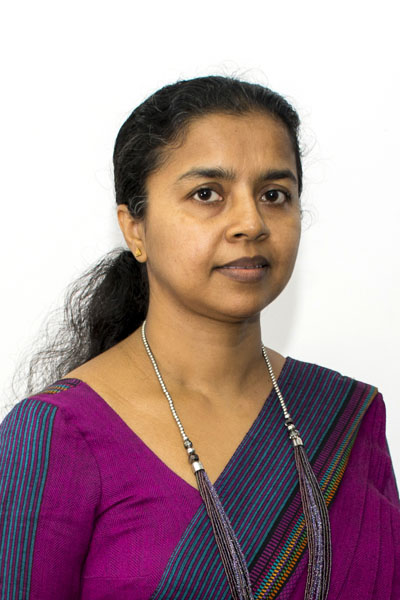Dr. Pradeepa Samarasinghe
August 8, 2023 2023-12-25 12:44
Dr. Pradeepa Samarasinghe
Assistant Professor
FACULTY OF COMPUTING | INFORMATION TECHNOLOGY
94117544111
- Dr. (Mrs.) Pradeepa Samarasinghe is an Assistant Professor in Information Technology, Sri Lanka Institute of Information Technology, Malabe, Sri Lanka.
- Dr. Samarasinghe joined SLIIT in 2005 as a Lecturer and held numerous positions
- Associate Dean, Faculty of Computing (January 2021 – June 2022),
- Head of Department, Department of Information Technology (April 2015 – May 2019),
- Postgraduate Course Coordinator – MSc in Information Technology
- Coordinator – BSc in Information Technology
- Chairperson of the Curriculum and Academic Quality Committee,
- Chair – IET Accreditation,
- Student Advisor.
- Before joining SLIIT, she worked at Virtusa (Pvt.) Limited as a Software Engineer/Technical Lead for more than seven years.
Academic Qualifications
- Ph.D, Australian National University, Canberra, Australia, 2012
- MBA in Information Technology, University of Moratuwa, Sri Lanka, 2007.
- BSc Eng. (Hons) in Computer Science and Engineering, University of Moratuwa, Sri Lanka, 1997
Honors and Awards
- Project Supervision Awards
- NBQSA – National ICT Awards 2020 – Diabetic Retinopathy staging using Artificial Intelligence
- NBQSA – National ICT Awards 2020 – Smart Chick Brooder System
- AI innovator gold award- SLIIT codefest 2019 – Deep Learning Based Screening and Intervention of Dyslexia, Dysgraphia and Dyscalculia
- 4th Commonwealth Health Digital Awards (Finalist) – Deep Learning Based Screening and Intervention of Dyslexia, Dysgraphia and Dyscalculia
- Best Professor in Information Technology Studies, The Sri Lanka Education Leadership Awards, 2019
- Sri Lanka National Research Council Merit Award for the publication “Analysis and performance of CMA blind deconvolution for image restoration”, 2018
- Teaching Excellence Award – SLIIT Awards, 2017
- ICT Student scholarship offered by CSIRO Australia (2009 – 2011).
- Australian National University scholarship (2008 –2011).
- Third prize in poster exhibition of Connecting Research to Business at ANU College of Engineering and Computer Science, Australia, 2009.
- Best Student Paper Award in the track of Intelligent Robots and Man-machine Co-existence in the International Conference on Information and Automation for Sustainability (ICIAFS) 2008.
- Computer Science Award for the best undergraduate project from Sri Lanka Association for the Advancement of Science (1998).
Interests
- Deep Learning
- Computer Vision
- Digital Health
- Emotion, gaze and attention recognition
- Human activity recognition and analysis
- Screening and Intervention
Memberships
- Senior Member – Institute of Electrical and Electronics Engineers (IEEE).
- Member – Institution of Engineering and Technology (IET).
- Associate Member – Institute of Engineers, Sri Lanka (IESL).
- Member – Computer Society of Sri Lanka (CSSL).
- Member – Organization for Women in Science for the Developing World (OWSD).
- Member – National Science Foundation, Sri Lanka (NSF)
CSAAT (sliit.lk), “>
AHEAD Project
- Restricted and Repetitive Behavior Analysis – The presence of restrictive and repetitive behaviors (RRBs), interests, and activities is one of the key indicators of Autism. Individuals may engage in stereotyped and repetitive motor movements (e.g., hand flapping, rocking, punching, drumming or lining up items) or speech. They may have an insistence on sameness. RRBs can be problematic when others interfere with the child’s way of behavior leading to anxiety and aggression. This research focuses on identifying the RRBs of the children and finding ways to automate the behavior analysis and prediction.
- Emotion Analysis – It has been found that there are significant differences in social interaction of children with ASD. Emotion expression and emotion recognition play key roles in social interaction. Children with Autism has shown poor emotion expression as well as recognition of others’ emotions. This research is aimed at developing an automated tool to identify the deficits in both emotion expression and recognition of children with Autism. The automated analysis of smile, imitation of facial expressions, responsiveness would signal an early indication of autistic symptoms.
- Gaze and Attention Analysis -Children with ASD have shown variant behaviors in eye contact, disengagement of visual attention, visual tracking and social interest and affect in comparison to typically developing (TD) children. These social cues that we measure, gaze and attention in particular, can be recorded in greater detail and at an early age which would give more opportunities for diagnosis of ASD and early intervention. Though there has been few research studies in developed countries using gaze patterns for autistic screening, the devices and technologies they have used are not affordable in Sri Lanka. This research area attempts to find affordable techniques for evaluating gaze and attention of children with Autism.
- Gait Analysis – A variety of movement disturbances including atypical gait, upper limb movements and postural control are also important as early signs of autism. Atypical gait is defined as an unusual style of walking from the normal pattern of walking and researchers have tried many different variables to test the abnormal gait patterns of children with ASD. Most studies have either used basic gait measurements, kinematic, kinetic or a combination of these. A limited research has been conducted on the link between infant motor skills and autism and much of the literature tend to provide a qualitative description of gait and motion based on the observation of clinicians. Thus, it is imperative to quantify these descriptions with measuring tools real time, specially starting as early as 6 months of age. Therefore, automated tools for quantitative gait and motion analysis have become vital for assessing pathologies manifested by atypical motor behaviors. This research is to analyze the gesture and gait patterns of children with Autism.
- Child Interaction Analysis – The main analysis on the CSAAT project involves videos of children for early detection of the autism spectrum disorder (ASD). Often, monitoring and quantifying the ability of children to interact with parents and professional therapists is essential in identifying any potential issues in their development growth. In this research, we plan to analyse the interactions between child and mother/examiner. This involves the use of image pre-processing techniques along with deep learning techniques such as graph neural networks to analyse the behaviours of the child as well as his/her interaction with others. The outcomes of this research may be useful in early identification and continuous monitoring of development goals and social interaction expectations of children.
- Culturally Sensitive Autism Assessment Tool (CSAAT) – Accelerating Higher Education Expansion and Development (AHEAD), World Bank funded Sri Lankan government operation grant.
- For more information, visit CSAAT (sliit.lk),
My Publications
CONFERENCE PROCEEDINGS
- Samarasinghe, P.D., Kennedy, R.A. On non-blind image restoration in International Conference on Signal Processing and Communication Systems, year 2009, Colombo, pp.1-7, IEEE,
- Chandrasiri, S. and Samarasinghe, P. Morphology based automatic disease analysis through evaluation of red blood cells in International Conference on Modelling and Simulation (ISMS), year 2014, pp.318-323, IEEE,
- Chandrasiri, S. and Samarasinghe, P. Automatic anemia identification through morphological image processing in International Conference on Signal Processing and Communication Systems, year 2014, pp.1-5, IEEE,
- R Kariyawasam, M Nadeeshani, H Tuan, I Subasinghe, P Samarsinghe, P Ratnayake Pubudu: Deep Learning Based Screening And Intervention of Dyslexia, Dysgraphia And Dyscalculia in Industrial and Information Systems (ICIIS), year 2019,
- Gayadeeptha, P., Baddewithana, T.P., Pannegama, K.V., Samarakkody, C.S., Samarasinghe, P. and Siriwardana, S EyeDriver: Intelligent Driver Assistance System in Conference on Industrial and Information Systems (ICIIS) , year 2020,
- Manchanayake, S.M.A.M., Samarasinghe, D.P., Perera, L.P.J., Bandara, H.M.M.T., Kumaradasa, K.C., Premadasa, N. and Samarasinghe, A.P., Potential Upselling Customer Prediction Through User Behavior Analysis Based on CDR Data. in 14th Conference on Industrial and Information Systems (ICIIS) , year 2019,
- Gamaethige, C., Gunathilake, U., Jayasena, D., Manike, H., Samarasinghe, P. and Yatanwala, T SenseA-Autism Early Signs and Pre-Aggressive Detector Through Image Processing in Asia Modelling Symposium (AMS) , year 2017,
JOURNAL PUBLICATIONS
- Pradeepa D Samarasinghe ” Analysis and performance of CMA blind deconvolution for image restoration “ International Journal of Adaptive Control and Signal Processing , vol.29, Issue 9, 2015, pp.1135-1151,
- B Wingfield, S Miller, P Yogarajah, D Kerr, B Gardiner, S Seneviratne, P Samarasinghe, and S Coleman. ” A Predictive Model for Paediatric AutismDetection in Low and Middle-Income Countries “ Health Informatics Journal, 2020, pp.1460458219887823,
BOOK CHAPTERS
- P. D. Samarasinghe and R. A. Kennedy, ” Regularized Image Restoration “ Image Restoration, 2012, InTech,


